CENTAUR: A 7- LIMIT (CAP) TUNING
Kraig Grady's 12 tone 7-limit scale and extensions showing other related scales developed by Wilson, Novaro, Narushima,Venkataramana, Doty, Hjertmann, Dakota, Poole, Schulter, Heathwaite, White and Gaertner.
Other scales of Grady can be found in the Journal of Anaphorian Music Theory
This chart shows the harmonic relations found in Centaur.

While this page is focused on Centaur, it should be noted that the original reed organ and the 2019 vibraphone are now tuned in the harmonic version of Centura below. It should be considered as one of the better options. A look at the constant structures within Centura has been compiled here. This scale was independently developed by Ben Hjertmann in 2022 who also tuned an Estey organ to it using 60 vps = 1/1. Centaura can also be thought of as a subset of the 15 tone scale of Praveen Venkataramana under Centaur Extensions down below which predates it.
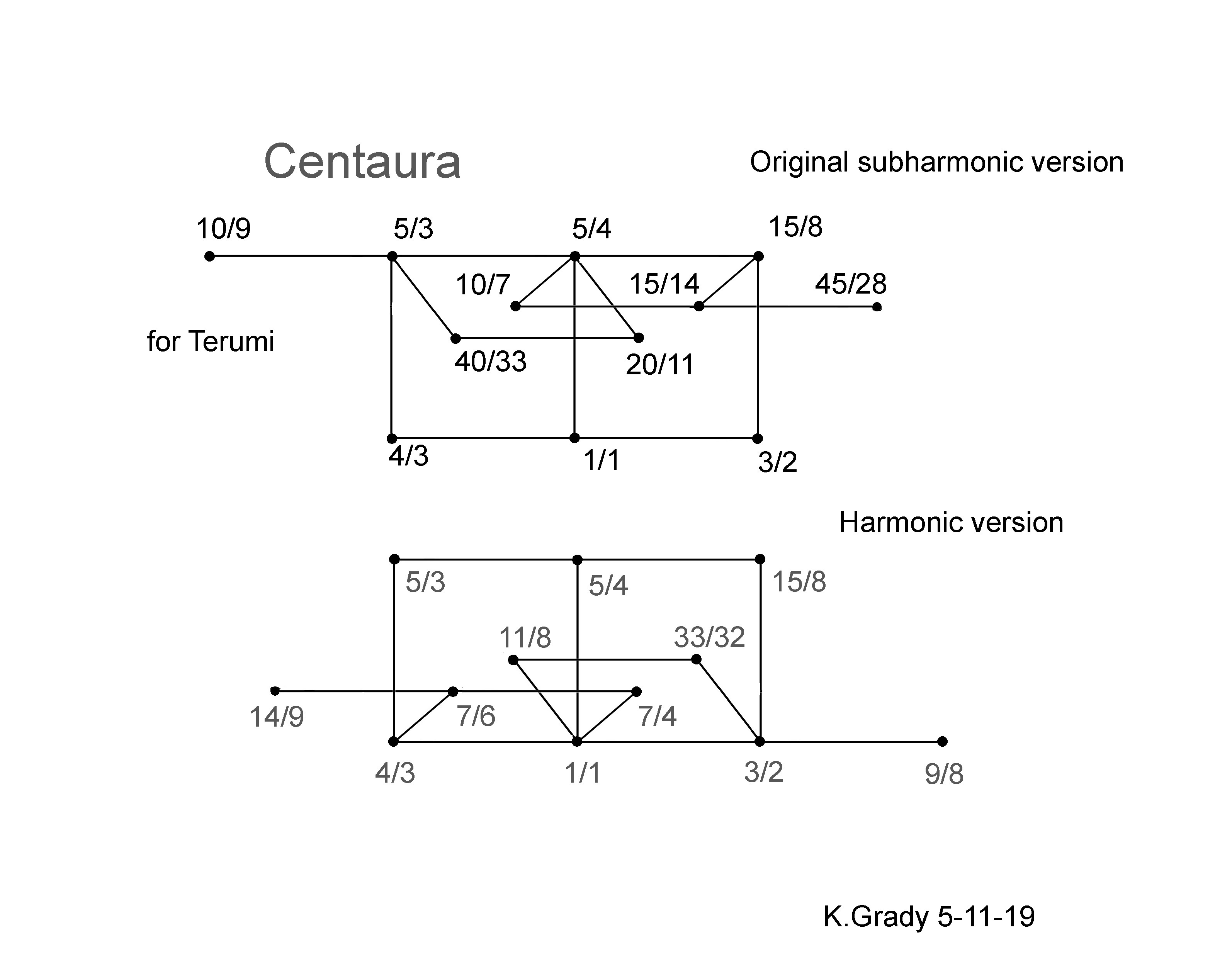
A cross section showing each note compared to every other.

A chart of all the intervals found and the variations found of each basic scale step size.

Here are the frequencies in case someone wishes to use Centaur in the original key or make a compatible instrument.

This is a chart of the 41 simple tetrads found in Centaur.
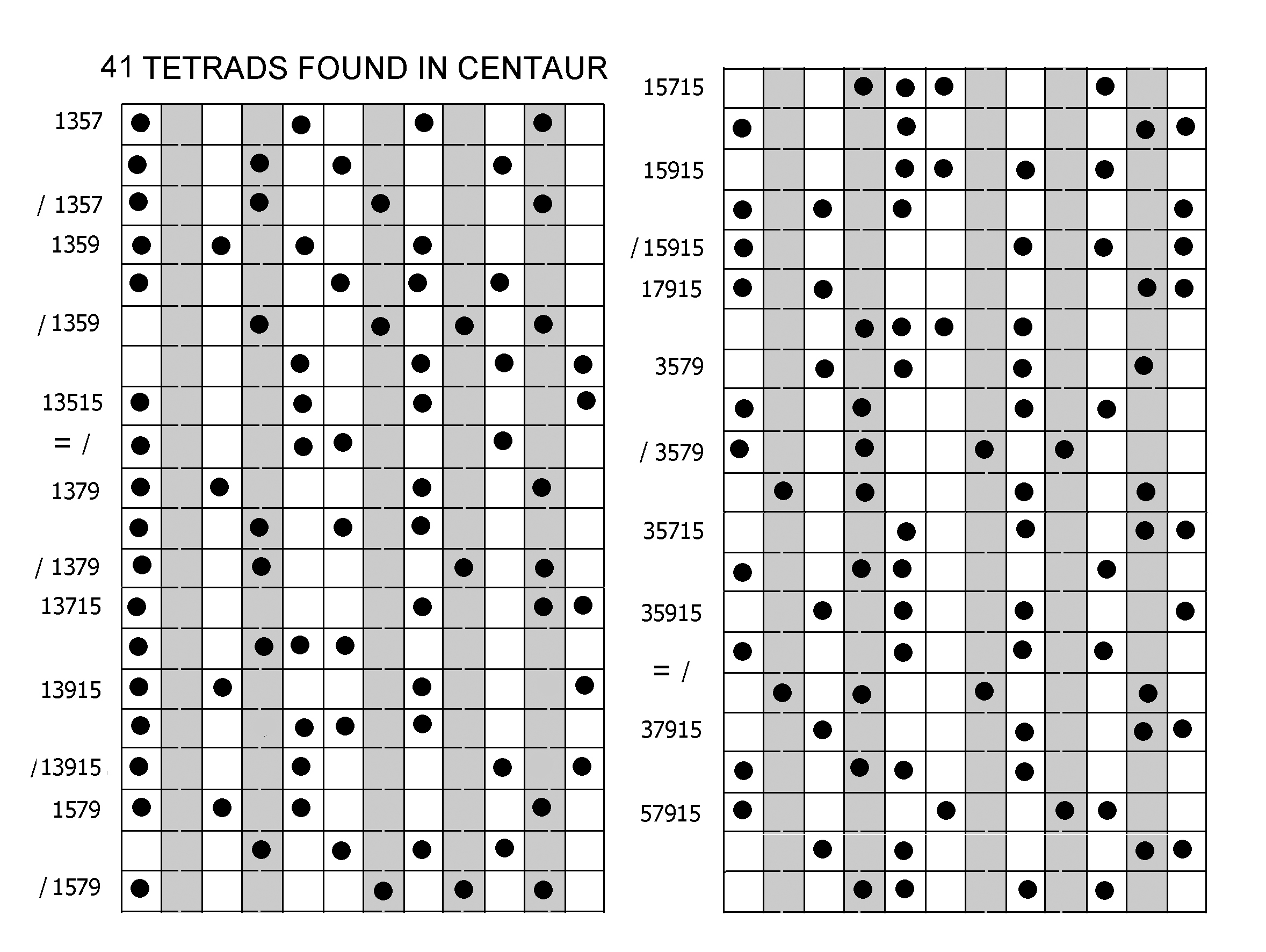
This chart shows the various diatonic-like scales expressed as a cycle of fifths. The melodic nature of this series helped in determining some of the pitches chosen over others in making this scale.

This diagram below was found in one of Wilson's notebooks.
The focus is on a 10-tone Constant Structure subset of Centaur similar to scales generated by the Viggo Brun algorithm.
This diagram illustrates a subset of 7-tone scales contained therein, showing the 10 cycles before it returns to the beginning.

It has been pointed out by Praveen Venkataramana that one can combine any of the like pairs in what he calls a Reverse Viggo Brun method with the result forming a Constant Structure.
This PDF shows the possible 10 through 6 tone scales that can be found using this method Centaur Constant Structures
It should be understood that Centaur an also exist in it mirror image being biased toward the subharmonic as opposed to the harmonic. Interestingly enough it is possible to combine the two with the addition of just 2 pitches forming a 14 tone constant structure.
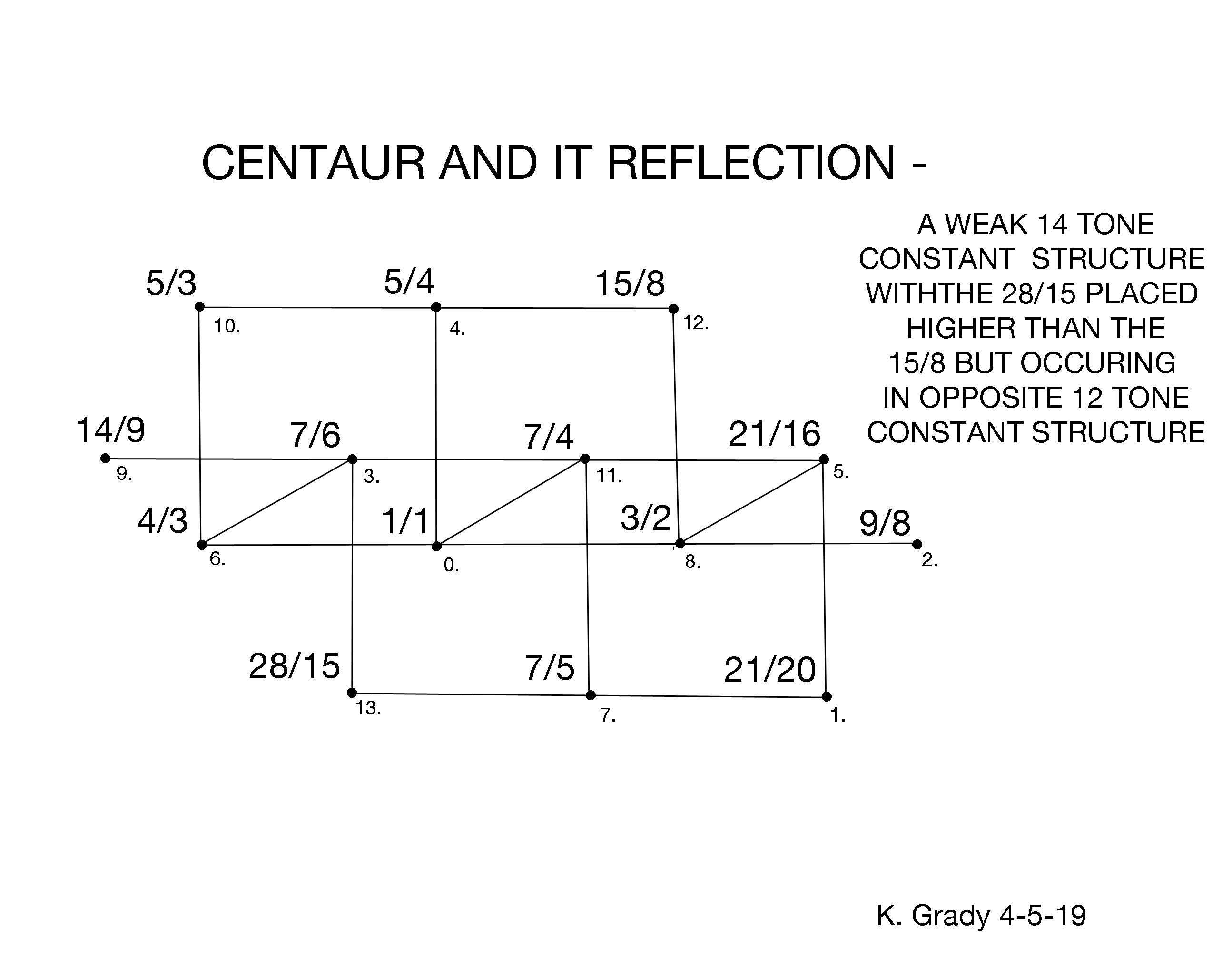
This document has quite a few 12 tone 7 limit tunings related to Centaur.
Here also is the 7 limit used by The Other Music Ensemble in San Francisco which uses 14 tones that has 11 tones in common with Centaur (this tuning was unknown to me at the time). Underneath is another possibility from when I first was making Centaur and uses a 28/27 which Other Music used before changing it to 15/14. I had a hard time deciding between 21/20 and the 28/27. The option has the advantage of another subharmonic series of 1-3-7-9 while Centaur provides another 1-3-5 along with repeated tetrachords that made me decide in its favor. Centaur also has no tone that doesn't have a 3/2 above or below it, leaving no tone unsupported.
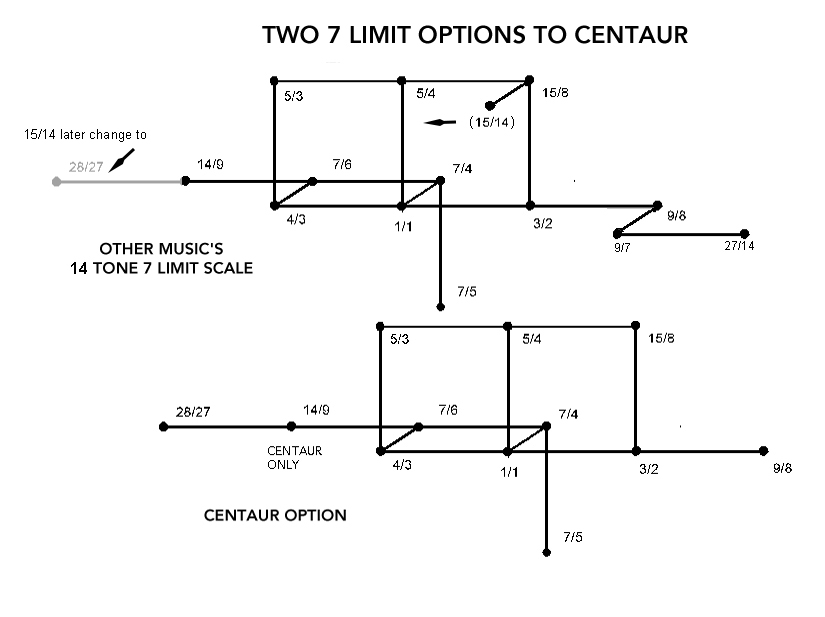
CENTAUR EXTENSIONS
Here is an interesting 11 limit extension Constant Structure of 15 tones [a somewhat rare number] by Praveen Venkataramana.
Other related lattices can be found
here.

It has been pointed out by Praveen Venkataramana that one can combine any of the like pairs in what he calls a Reverse Viggo Brun method with the result forming a Constant Structure.
Some possible 10, 9, 8 and 6 tone scales in Centaur using this method can be found here.
This is a 17 tone Constant Structure extension of Centaur by Terumi Narushima.

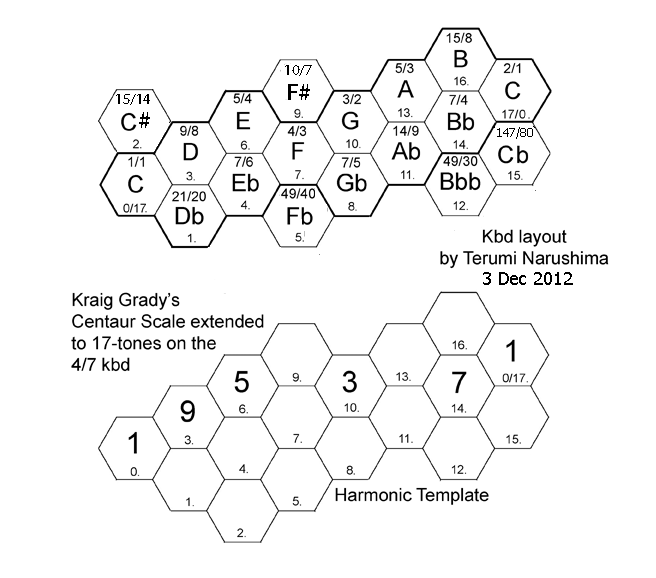
This is Novaro's 23 tone scale he proposed to encompass the 9 limit diamond. What is interesting is that the diamond proper does not include Centaur, but with the added 4 notes, Centaur can be found imbedded in his scale as well as it inversion.

SOME CLOSE RELATIVES TO CENTAUR
This is a very closely related 14-tone scale that shares 11 notes in common with the Centaur scale in two instances a fifth apart.
It first appeared in Lou Harrison's Music Primer.



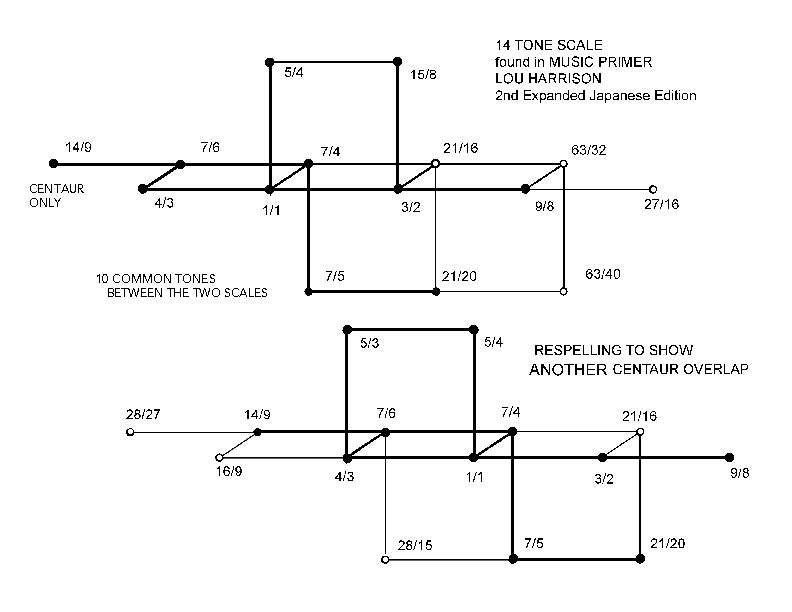

A second Wilson 19 tone extension of Centaur below includes all of Centaur. there is an 11 limit scale drawn above to show and option where one could retune those two notes to which are approx. 5 cents lower

The first Wilson 19 tone extension of Centaur mentioned above can be compared to Terumi Narushima's 19 tone scale where a 14/9 and 5/3 are used instead of a 27/16 and 63/40. The other solution made by Wilson uses the 35/27 and 35/18 instead of the 21/16 and 63/32 of the Narushima below.

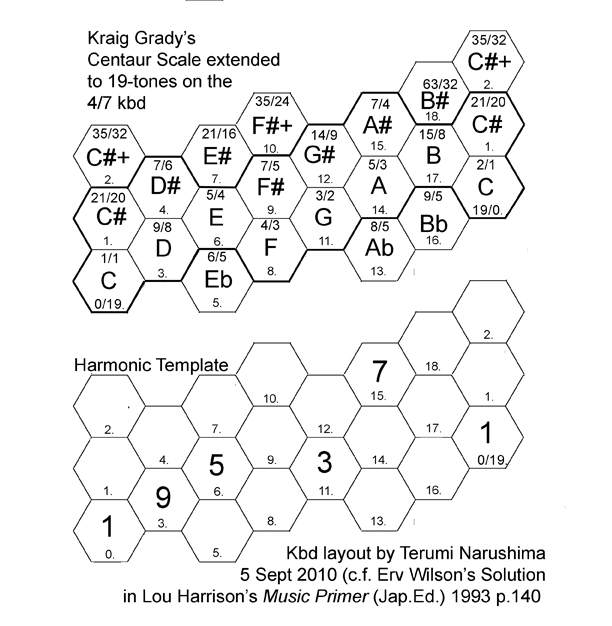
Below is a slight variation worked out especially when writing for string ensembles where one might wish to preserve the traditional open string tunings.
A discussion on it can be found
here

This is 17 tone scale of Wilson, which has a 10 tone overlap with Centaur and extends into the 11 limit territory with two subharmonic hexads instead of only one. Conceptually it shares the idea of having both harmonic and/or subharmonic forms a 3/2 apart.
The scale is discussed on this page of the
Gems of the Wilson Archives Blog.
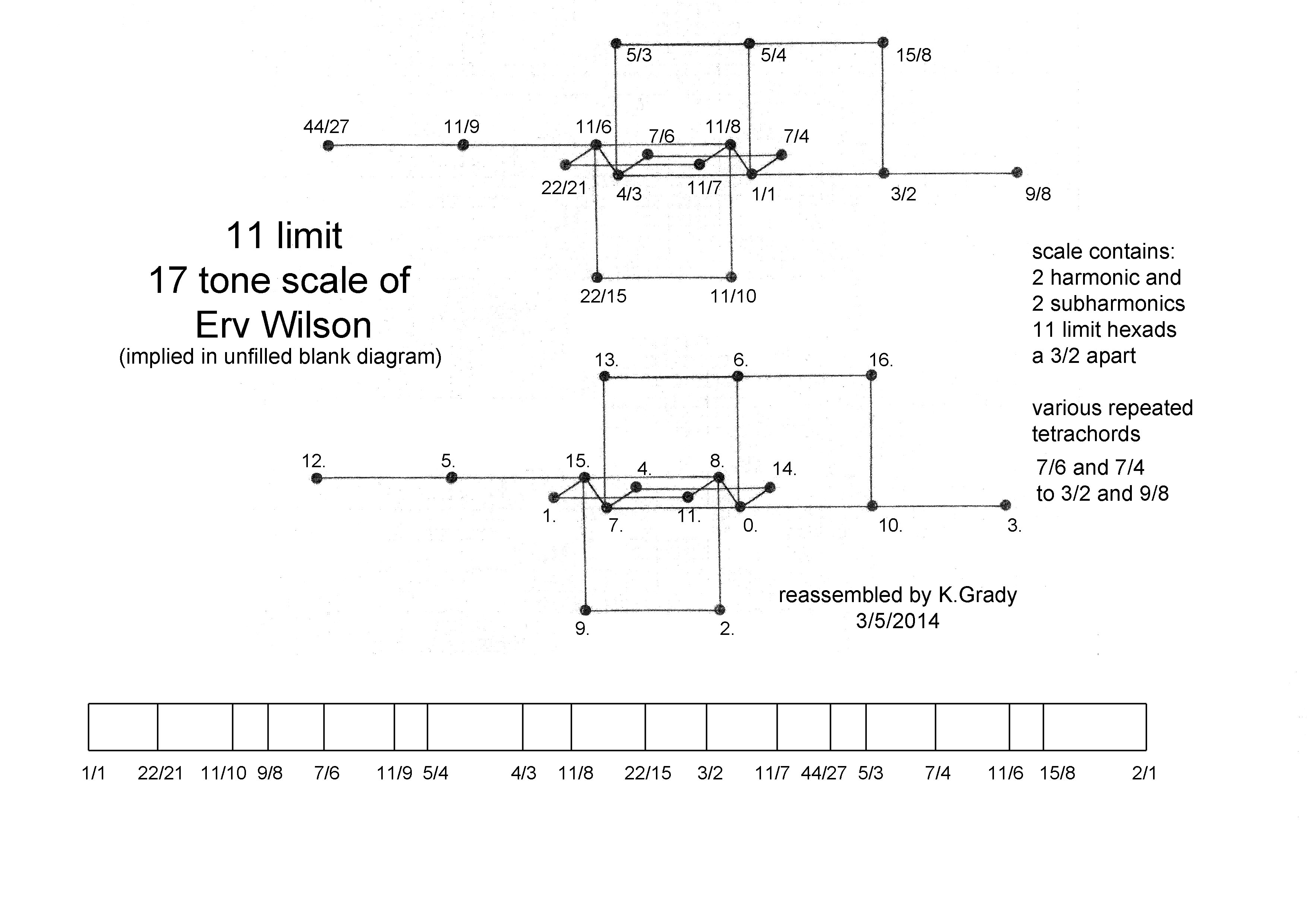
Independently this 12 tone subset of the above scale was found looking for a Centaur-like scale with 11s instead of 5s.


Ben Hjertmann who is mentioned above in relation to Centaura also developed this 12 11 limit scale on piano that fits well in relation to Sisiutl

INDEPENDENT SCALES HAVING CLOSE RELATIONS WITH CENTAUR
Monarda is a JI version of Scott Dakota's scale that includes 2 harmonic sets a 3/2 apart, and explores the use of the 17th harmonic.

Monarda inspired the slight variation below by myself which exchanges some features at the expense of others.

Justin White devised the following scale after seeing Wilson's 19 tone one above that also is an epimoric scale. White describes his scale as "Designed to incorporate more resources from the Boomsliter and Creel blues reference, but omitting notes that are too close to already existing pitches (e.g. 14/9, 21/20 were left out because they are too close to 25/16 and 25/24)".

The guitarist and improviser Rod Poole originally used Centaur as the base pitches to construct his various tunings on his guitar. While over time the variations took him in a new direction, it shows how a scale can develop into new territory.
Here is one suggestion Erv Wilson made to Rod that includes Centaur within a 22-tone scale.

Here is a 29 tone scale Erv attributes to Rod Poole three months later than the above. This scale adds 17 tones to Centaur. It is worth noting that the 17 that Rod ended up using is marked with small check marks on close examination. Margo Schulter has written here about another scale interaction of Poole and Wilson. Margo Schulter has developed an extended array of related scales to Centaur and Poole's scale found here.
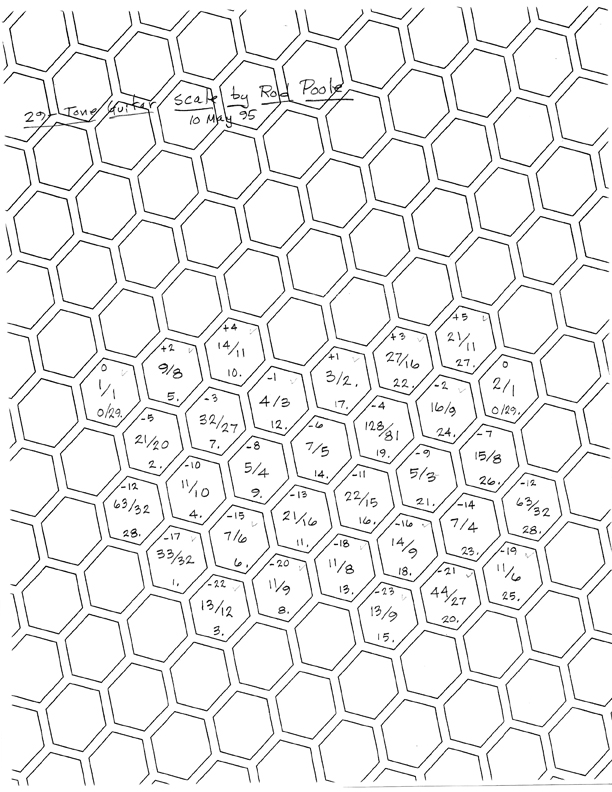
This is the last scale we have of Rod Poole. Centaur is in red of which the hollow notes were omitted as he decided to drop the 5 limit ratios and expand the scale in both the 11 and 13 directions [shown in black].

Andrew Heathwaite's guitar tuning Cartwheel is another 17 tone 13 limit Constant Structure that overlaps significantly with both Centaur, Poole's, and Schulter's tunings focusing on the harmonic direction.

Here is a closely related scale by Owen Gaertner of the band Horse Lords. While other guitar tunings can use various open tunings, in his case he is quite specific in using an open tuning of 6:8:12:16:21:24.

The Centaur page shows how a just intonation scale can be taken as a starting point, and greatly expanded or contracted into something related. It also demonstrates how similar just intonation scales can be developed independently and have many points of overlap and shared contact.


Other scales of Grady can be found in the Journal of Anaphorian Music Theory






































